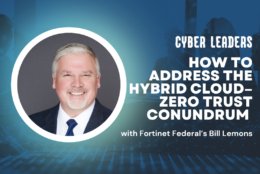Cybersecurity
-
Join us for a panel discussion with moderator, Tom Temin, and agency and industry leaders who will discuss the latest thinking in achieving mission assurance and data protection using zero trust, segmentation and monitoring strategies.
September 26, 2023 -
NSA, OPM and the State Department are using new tactics and methods to recruit and retain cyber workers as these positions become harder to fill.
September 25, 2023 -
Lawmakers are paying close attention to how CISA revamps its flagship federal cyber programs, like Continuous Diagnostics and Mitigation.
September 21, 2023 -
DHS' recommendations come amid a growing patchwork of cyber incident reporting rules and regulations.
September 19, 2023 -
Join Tom Temin and SAIC's Shawn Kingsberry as they explore how to enhance your IT modernization effort through zero trust strategies.
September 19, 2023 -
In today's Federal Newscast: After three crashes, two of them deadly, the Marines halt aviation for two days. A DHS threat assessment warns of "likely" cyber-attacks on America's 2024 elections. And GAO has given its employees several hybrid and remote work options.
September 19, 2023 -
As technology advances, future trends in AI, such as natural language processing and AI-based analytics, promise to further enhance CUI handling. Government agencies must remain adaptable to embrace emerging technologies to stay ahead in safeguarding sensitive information.
September 18, 2023 -
With thousands of suppliers supporting operations globally, the space agency knew it needed to harmonize supply chain risk management across its 11 mission centers. Kanitra Tyler, who leads this work, gives us a peek behind the SCRM curtain at NASA.
September 15, 2023 -
The Office of the National Cyber Director this summer released a National Cyber Strategy Implementation Plan that includes 69 initiatives. But ONCD’s Nick Leiserson explains that the plan will not — really cannot — be static guidance.
September 15, 2023 -
It’s not even close to the end of the journey — there won’t be an end — but three Navy IT leaders share how the service achieved a working zero trust model that serves the vast majority of the users on its enterprise networks.
September 15, 2023 -
In DHS and NIST labs, researchers study known knowns but also unknown unknowns on the cyber horizon. We talk to three such researchers to learn about their work and about helping agencies become agile and resilient in the face of such cyberthreats.
September 15, 2023 -
Given that agencies are on the clock to adopt zero trust architectures by fiscal 2025, Fortinet Federal’s Bill Lemons offers tactics federal IT teams can take if going all in on cloud, which makes zero trust implementation easier, is not an option.
September 15, 2023 -
As agencies continue to evolve their cyber capabilities, some preparatory basics still apply. The Federal Drive’s Tom Temin talks with Infoblox’s Allen McNaughten to get the lowdown on three things agencies should still be doing.
September 15, 2023 -
The Federal Zero Trust Strategy emphasizes visibility. It matters because “that’s how you detect compromised controls, compromised appliances, compromised firewalls. … Look at the traffic because that’s where the truth is,” Gigamon’s Ian Farquhar says.
September 15, 2023 -
With the National Cyber Strategy putting a premium on securing technology supply chains, public-private collaboration as well as cross-vendor initiatives have become essential, shares Dell Technologies’ Daniel Carroll.
September 15, 2023
















